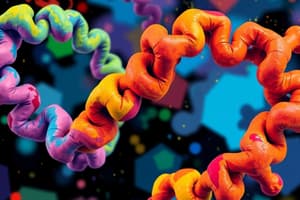Podcast
Questions and Answers
What is the primary function of a protein's quaternary structure?
What is the primary function of a protein's quaternary structure?
- To regulate enzyme activity
- To facilitate the arrangement of subunits (correct)
- To provide a specific binding site for a substrate
- To determine the overall shape of a protein
Which of the following is NOT a characteristic of enzyme kinetics?
Which of the following is NOT a characteristic of enzyme kinetics?
- Inactivation by denaturation
- Optimal temperature and pH
- Linear increase in reaction rate with increasing substrate concentration (correct)
- High specificity for substrates
What is the primary function of the pentose phosphate pathway?
What is the primary function of the pentose phosphate pathway?
- To generate ATP and NADH
- To synthesize fatty acids
- To generate NADPH and pentoses (correct)
- To break down glucose into pyruvate
Which of the following types of inhibition is characterized by an inhibitor binding to the enzyme-substrate complex?
Which of the following types of inhibition is characterized by an inhibitor binding to the enzyme-substrate complex?
What is the primary function of fatty acid synthase complex?
What is the primary function of fatty acid synthase complex?
What percentage of kidney stones are composed of struvite?
What percentage of kidney stones are composed of struvite?
Which type of kidney stone is more common in males than females?
Which type of kidney stone is more common in males than females?
What is the most common type of kidney stone?
What is the most common type of kidney stone?
Which type of kidney stone is often associated with certain genetic disorders?
Which type of kidney stone is often associated with certain genetic disorders?
What is a common underlying cause of struvite stones?
What is a common underlying cause of struvite stones?
Study Notes
Proteins
- Structure:
- Primary structure: sequence of amino acids
- Secondary structure: α-helix, β-pleated sheet, and random coil
- Tertiary structure: 3D shape of a protein
- Quaternary structure: arrangement of subunits
- Functions:
- Enzymes: catalyze reactions
- Transport: transport molecules and ions
- Storage: store and release molecules
- Regulation: regulate metabolic pathways
- Defense: immune system proteins
- Denaturation:
- Unfolding of protein structure
- Caused by heat, pH, and chemicals
- Loss of biological function
Lipid Metabolism
- Fatty Acid Oxidation:
- β-Oxidation: breakdown of fatty acids into acetyl-CoA
- Electron transport chain: generation of ATP
- Fatty Acid Synthesis:
- De novo synthesis: synthesis of fatty acids from acetyl-CoA
- Fatty acid synthase complex: enzyme complex involved
- Triacylglycerol Metabolism:
- Triacylglycerol synthesis: esterification of glycerol and fatty acids
- Lipolysis: breakdown of triacylglycerols into fatty acids and glycerol
Enzymology
- Characteristics:
- High specificity for substrates
- Optimal temperature and pH
- Inactivation by denaturation
- Kinetics:
- Michaelis-Menten equation: describes enzyme-substrate interaction
- Km: Michaelis constant, measure of enzyme-substrate affinity
- Vmax: maximum reaction rate
- Inhibition:
- Competitive inhibition: inhibitor binds to active site
- Non-competitive inhibition: inhibitor binds to allosteric site
- Uncompetitive inhibition: inhibitor binds to enzyme-substrate complex
Metabolic Pathways
- Glycolysis:
- Breakdown of glucose into pyruvate
- Anaerobic: no oxygen required
- Produces ATP and NADH
- Citric Acid Cycle (Krebs Cycle):
- Breakdown of acetyl-CoA into CO2
- Produces ATP, NADH, and FADH2
- Electron transport chain: generates ATP
- Pentose Phosphate Pathway:
- Generation of NADPH and pentoses
- Important for nucleic acid synthesis and antioxidant defense
Proteins
- Primary structure of a protein is the sequence of amino acids
- Secondary structure includes α-helix, β-pleated sheet, and random coil
- Tertiary structure refers to the 3D shape of a protein
- Quaternary structure is the arrangement of subunits
Protein Functions
- Enzymes catalyze reactions
- Transport proteins transport molecules and ions
- Storage proteins store and release molecules
- Regulatory proteins regulate metabolic pathways
- Defense proteins are involved in the immune system
Denaturation
- Unfolding of protein structure resulting in loss of biological function
- Caused by heat, pH, and chemicals
Lipid Metabolism
- Fatty acid oxidation involves β-oxidation, breaking down fatty acids into acetyl-CoA
- Electron transport chain generates ATP during fatty acid oxidation
Fatty Acid Synthesis
- De novo synthesis involves the synthesis of fatty acids from acetyl-CoA
- Fatty acid synthase complex is the enzyme complex involved in fatty acid synthesis
Triacylglycerol Metabolism
- Triacylglycerol synthesis involves the esterification of glycerol and fatty acids
- Lipolysis breaks down triacylglycerols into fatty acids and glycerol
Enzymology
- Enzymes have high specificity for substrates
- Enzymes have optimal temperature and pH
- Enzymes can be inactivated by denaturation
Enzyme Kinetics
- Michaelis-Menten equation describes enzyme-substrate interaction
- Km represents the Michaelis constant, a measure of enzyme-substrate affinity
- Vmax represents the maximum reaction rate
Enzyme Inhibition
- Competitive inhibition occurs when an inhibitor binds to the active site
- Non-competitive inhibition occurs when an inhibitor binds to an allosteric site
- Uncompetitive inhibition occurs when an inhibitor binds to the enzyme-substrate complex
Metabolic Pathways
- Glycolysis breaks down glucose into pyruvate
- Glycolysis is an anaerobic process, requiring no oxygen
- Glycolysis produces ATP and NADH
Citric Acid Cycle (Krebs Cycle)
- Citric acid cycle breaks down acetyl-CoA into CO2
- Citric acid cycle produces ATP, NADH, and FADH2
- Electron transport chain generates ATP during citric acid cycle
Pentose Phosphate Pathway
- Pentose phosphate pathway generates NADPH and pentoses
- Pentose phosphate pathway is important for nucleic acid synthesis and antioxidant defense
Types of Kidney Stones Overview of different types of kidney stones (e.g., calcium oxalate, uric acid, struvite, cystine) Brief description of each type and their prevalence
Studying That Suits You
Use AI to generate personalized quizzes and flashcards to suit your learning preferences.
Description
Understand the structure of proteins, including primary, secondary, tertiary, and quaternary structures, and their various functions such as enzymes, transport, storage, regulation, and defense. Learn about protein denaturation and its effects.



